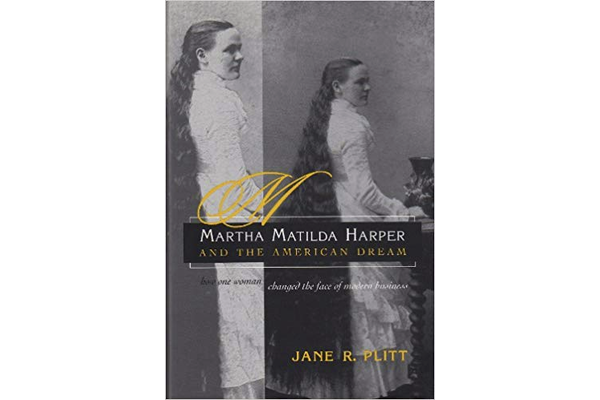Beyond the Vote, The Suffragists Helped Launch Modern Business Franchising
As we begin to celebrate the 100th anniversary of the 19th amendment, giving women the right to vote, we should also acknowledge the role of the suffrage movement in supporting the launch of modern franchising begun by Martha Matilda Harper in 1891.
Harper was born near Oakville, Ontario, Canada, and at age seven, she was bound out into servitude. For the next twenty-five years, she remained a servant, but was determined to find a path out of her poverty- stricken world. Fortunately, her last Canadian employer was a holistic doctor who taught her about healthy hair care including demonstrating the power of his proprietary hair tonic. As a result, Harper had Rapunzel-like floor length hair. On his deathbed, the doctor bequeathed Harper the hair tonic formula. With it, she left Canada in 1882 and emigrated to Rochester, NY, a hotbed of entrepreneurial innovation and social advocacy.
Harper remained a servant for six more years until she opened Rochester’s first beauty salon for women with her lifetime savings of $360 in 1888. That was the same year George Eastman launched the KODAK camera with one million dollars of venture capital. Harper located her salon in the most fashionable office building in Rochester, where people banked, visited art galleries, took music lessons, and conducted various business transactions. It happened that Susan B. Anthony’s trusted lawyer, former Congressman John Van Voorhis, was located in that building.
Harper surely knew of that building from serving Rochester’s society folks and wisely chose to locate there. However, Daniel Powers, the building owner, was reluctant to allow Harper to start such a questionable business, fearing it would attract prostitutes and the wrong kind of women to his fancy building. Cleverly, Harper enlisted Van Voorhis to advocate for her and he succeeded. Van Voorhis additionally provided two key contacts to support Harper: his wife, a society lady, and his former client Susan B. Anthony. Both ended up playing major roles in Harper’s success.
A keen observer and well taught in the art of pleasing, Harper invented the first reclining shampoo chair and cut out a neck rest along the sink’s rim to make hair shampooing a more comfortable process. She also invited mothers bringing their children to music lessons next door to rest their weary feet in her salon. Astutely, she even posted a picture of her flowing floor-length hair on the exterior of her office door to attract customers. With this inventiveness, she wowed Rochester women, recruiting Anthony and many others.
It is said that Anthony and Harper had long discussions about women’s rights and the cause of full equality during treatments. During those discussions and with Anthony’s advocacy, suffragists began to patronize her shop and became a niche of growing Harper’s customer base. As Rochesterian Mrs. Josephine Sargent Force indicated, “I was brought up a suffragist and was interested in Miss Harper and her work and was interested in anything women were doing.”
Suffragists understood the bigger issues facing women. In the 1848 Declaration of Sentiments, Elizabeth Cady Stanton and others spoke about the restrictions of women’s education and job prospects. These limitations assured women were destined to earn meager wages as servants or factory workers. In addition the Declaration took on coverture,a legal term that referred to the limitation of women's possessions including wages, children and property. Stanton and the suffragists were envisioning a world where women would be independent of such legal restrictions. Susan B. Anthony understood all of this. She understood the vote was simply a first step to emancipating women. Thus she declared, “Every woman needs a pocketbook, ” suggesting that the control of money was essential for women’s equality.
Harper was likely influenced by this philosophy as she expanded economic opportunities for herself and other women. Enter Bertha Palmer, Chicago socialite, who was lured to Rochester to experience the Harper Shop. She loved the experience and told Harper that she wanted such a shop in Chicago in time for the 1893 Chicago World Exposition, where she would be the President of the Women’s Division. Boldly, Harper countered Palmer, informing Palmer that she would need to deliver a written commitment from 25 of Palmer’s best friends assuring future patronage at a Chicago Harper shop. Palmer delivered and then Harper had to figure out how to expand.
Cleverly, Harper used the Christian Science Church structure as something she could replicate, with herself as the strong female leader, her Rochester headquarters like the Mother Church in Boston, and then satellite shops around the world that followed Harper’s instructions and used her products. For the first 100 Harper shops, Harper put only poor women into ownership positions of each shop. Harper, thereby, was also a pioneer of social entrepreneurship. Ultimately, there were 500 such franchises around the world. British royalty, the German Kaiser, U. S. Presidents and their First Ladies, suffragists, luminaries were all loyal Harper customers.
Harper’s success was recognized around the world. When she died in 1950 even the NY Times wrote a two -column obituary about Harper, citing her relationship with Anthony. Unfortunately, Harper’s achievements and the role of the suffragists in creating this new business model has been forgotten. It is time to credit Harper and the suffragists with the fastest growing segment of retailing— franchising. As Susan B. Antony understood, though, that was only part of the goal. The other was to assure that all women had their own purse for financial independence and choice. Perhaps by August 26, 2020, real pay equity for women and widespread recognition for forgotten achievements of women like Harper will have been established. Then, the ultimate goal of the suffragists will have been met and we can all cheer!
©Jane R. Plitt 2019
